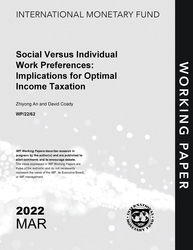
Social Versus Individual Work Preferences: Implications for Optimal Income Taxation
Social Versus Individual Work Preferences: Implications for Optimal Income Taxation
READ MORE...
Volume/Issue:
Volume 2022
Issue 062
Publication date: March 2022
ISBN: 9798400206474
$0.00
Add to Cart by clicking price of the language and format you'd like to purchase
Available Languages and Formats
| English |
Topics covered in this book
This title contains information about the following subjects.
Click on a subject if you would like to see other titles with the same subjects.
Labor , Economics- Macroeconomics , Taxation - General , Economics / General , Preference Differences , Optimal Income Taxation , Wage Subsidies , Progressivity , taxation model , preference difference , model of Mirrlees , income taxation , MIT schedule , Marginal effective tax rate , Income tax systems , Income , Labor supply , Employment subsidies
Also of interest
Summary
The benchmark optimal income taxation model of Mirrlees (1971) finds that the optimal marginal income tax rate (MIT) is always non-negative. A key model assumption is the coincidence between social and individual work preferences. This paper extends the model to allow for differences in social and individual work preferences. The theoretical and simulation analyses show that under this model, when the government places a higher social weight on work than individuals, the optimal MIT schedule is shifted downwards, introducing the possibility for optimal wage subsidies at the bottom of the income distribution. This implies lower revenues, demogrants, and overall progressivity.
Copyright © 2010 - 2026
Powered by:
AIDC



